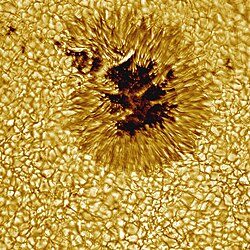Stars/Sun/Heliography/Quiz
Heliography is a lecture focusing on the features of the Sun's surface. It is a lecture as part of the radiation astronomy course on solar astronomy.

You are free to take this quiz based on heliogony at any time.
To improve your score, read and study the lecture, the links contained within, listed under See also, External links, and in the {{radiation astronomy resources}} template. This should give you adequate background to get 100 %.
As a "learning by doing" resource, this quiz helps you to assess your knowledge and understanding of the information, and it is a quiz you may take over and over as a learning resource to improve your knowledge, understanding, test-taking skills, and your score.
Suggestion: Have the lecture available in a separate window.
To master the information and use only your memory while taking the quiz, try rewriting the information from more familiar points of view, or be creative with association.
Enjoy learning by doing!
Quiz
edit
Hypotheses
edit- Phenomena occurring above or below the surface of the Sun alter its appearance.
See also
editExternal links
edit{{Radiation astronomy resources}}